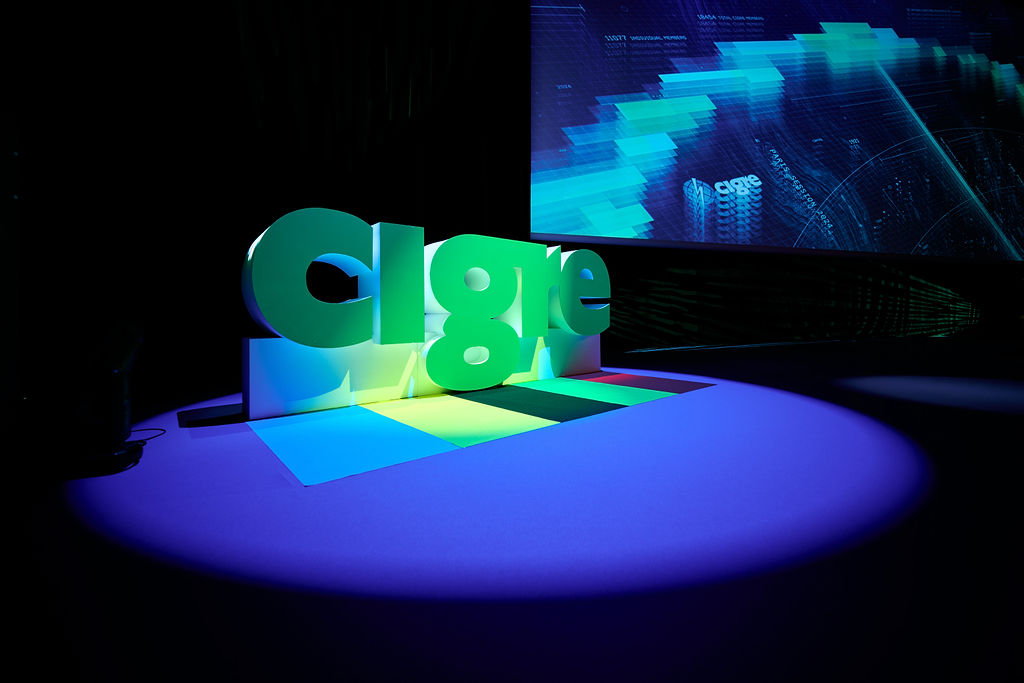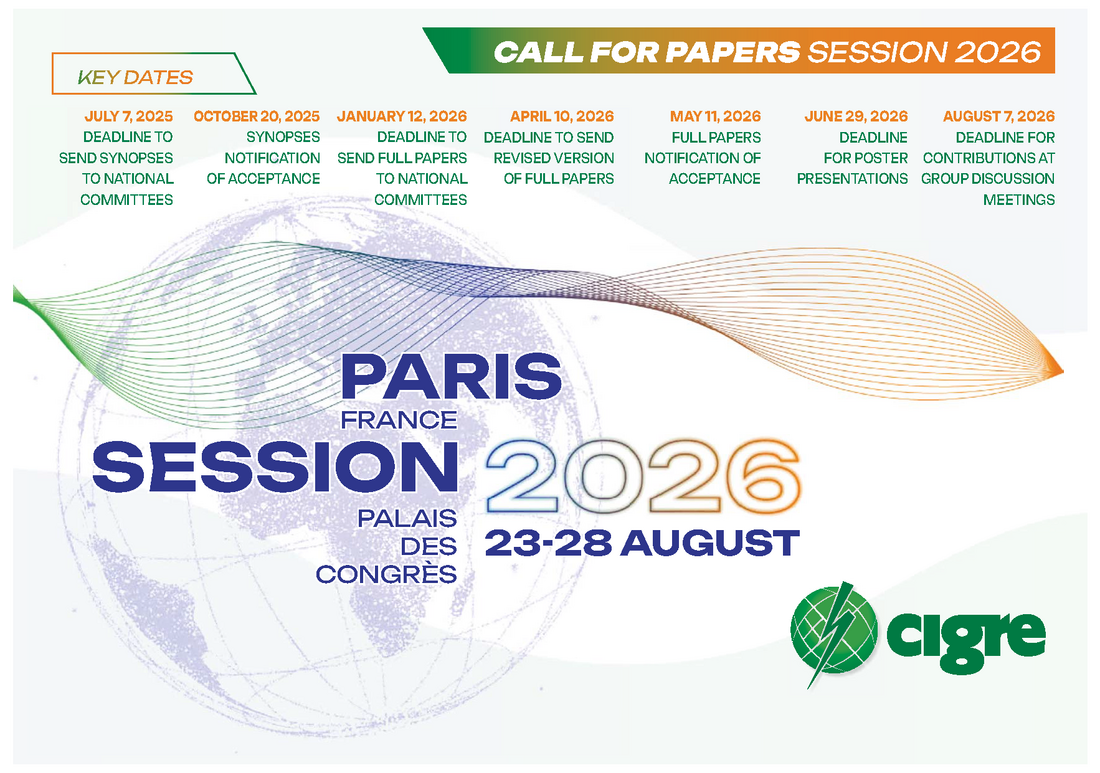CIGRE Session 2026 - Call for papers
Submit a paper for the number one global Power System event in the world and experience an exclusive opportunity as author to take the floor and address a large audience!
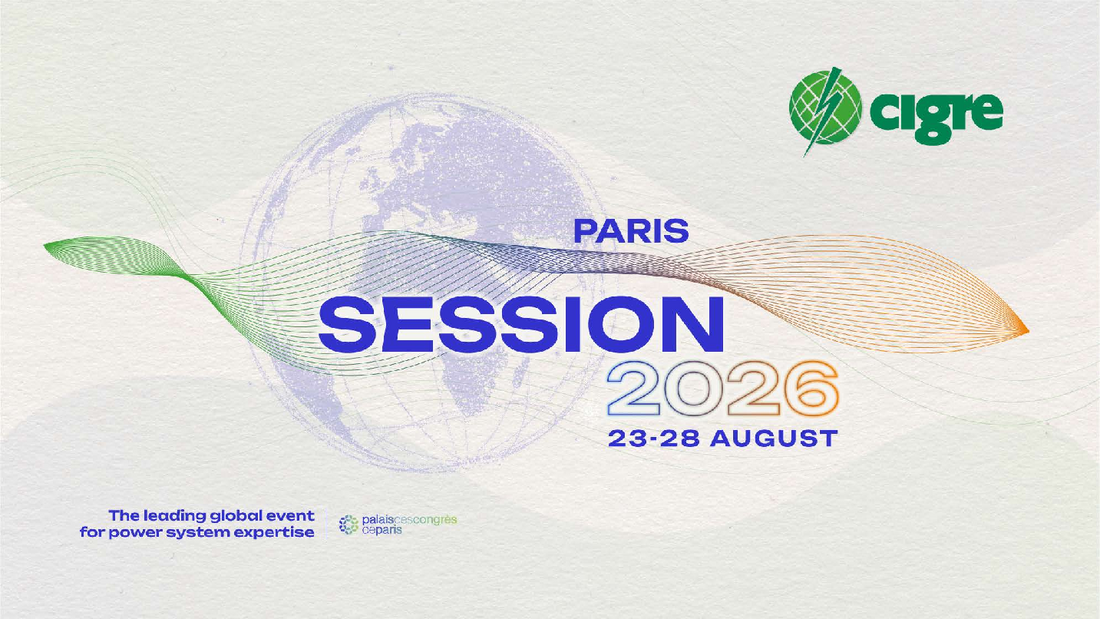
A few words about the Paris Session: Much more than a traditional conference
As the leading global event for power system expertise, CIGRE Session offers Delegates a unique and comprehensive experience with two must-attend events: Group Discussion Meetings and Poster Sessions.
Group Discussion Meetings
Spanning the end-to-end power system, the 16 Study Committees of CIGRE will each host Group Discussion Meetings and Poster Sessions.
After reviewing and examination of the Session Papers, our Special Reporters compile questions, that are not specifically aimed at the papers’ authors, but are synthesised from common issues and trends identified in across the papers. Session attendees are encouraged to share their views and experiences in response to these specific questions. This provides the opportunity for a broader response and participation in the Group Discussion Meetings.
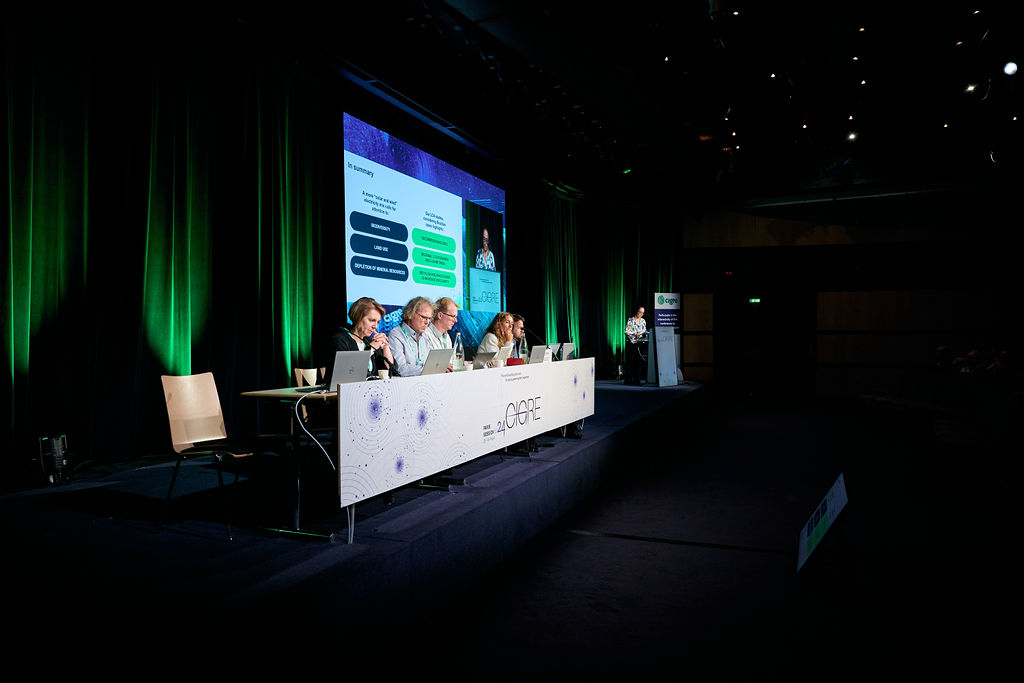
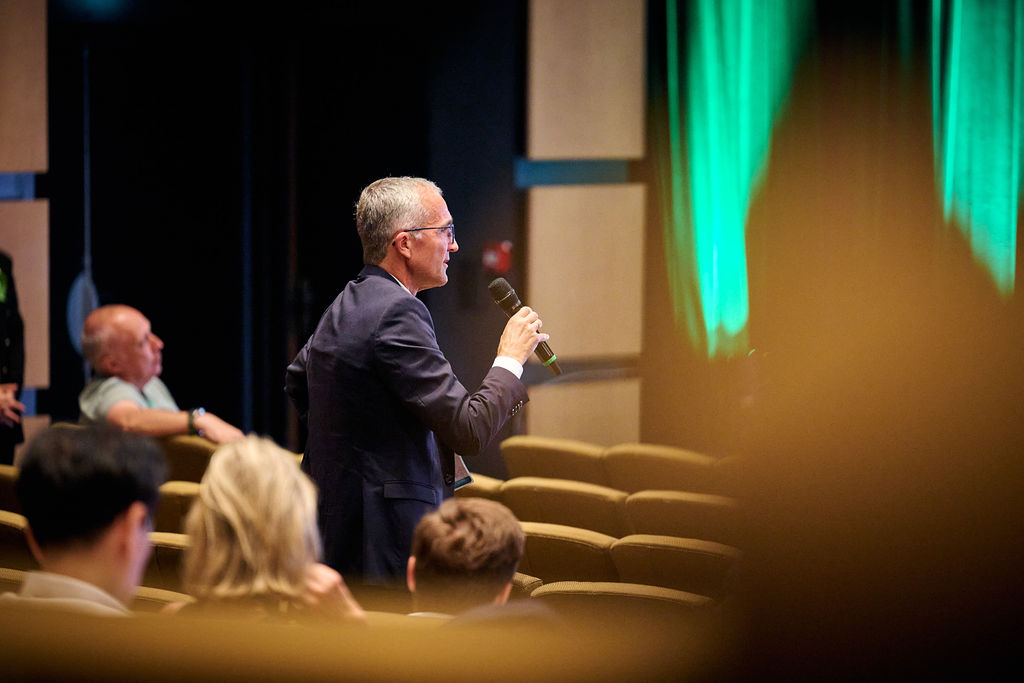
2 or 3 slides for a 5 - 10 minutes presentation is a usual format.
The meeting convener asks each contributor to take the floor and present the contribution to the audience, with a speaking time schedule set up in advance.
Authors and intended contributors should prepare their slides in advance and make them available to Study Committees for a prior check and more more optimal organization of the meetings. Templates and instructions will be posted on CIGRE Session website and circulated to all a few months ahead the Session. National Committees will not be involved in the process.
Contributors will upload their prepared contributions directly through their personal account on the registration portal.
Poster sessions
Since their creation, Poster Sessions are proved very popular and appreciated by both Authors and Session Delegates. Poster Sessions are a unique opportunity for authors to present their Papers in a convivial working atmosphere during fruitful exchanges with the Session Delegates.
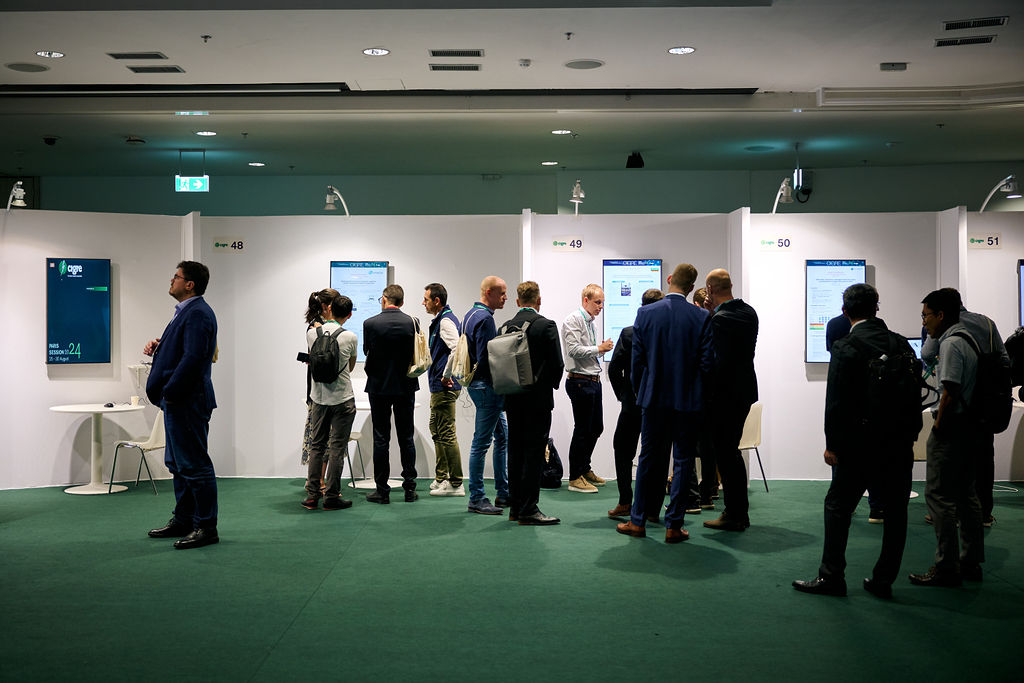
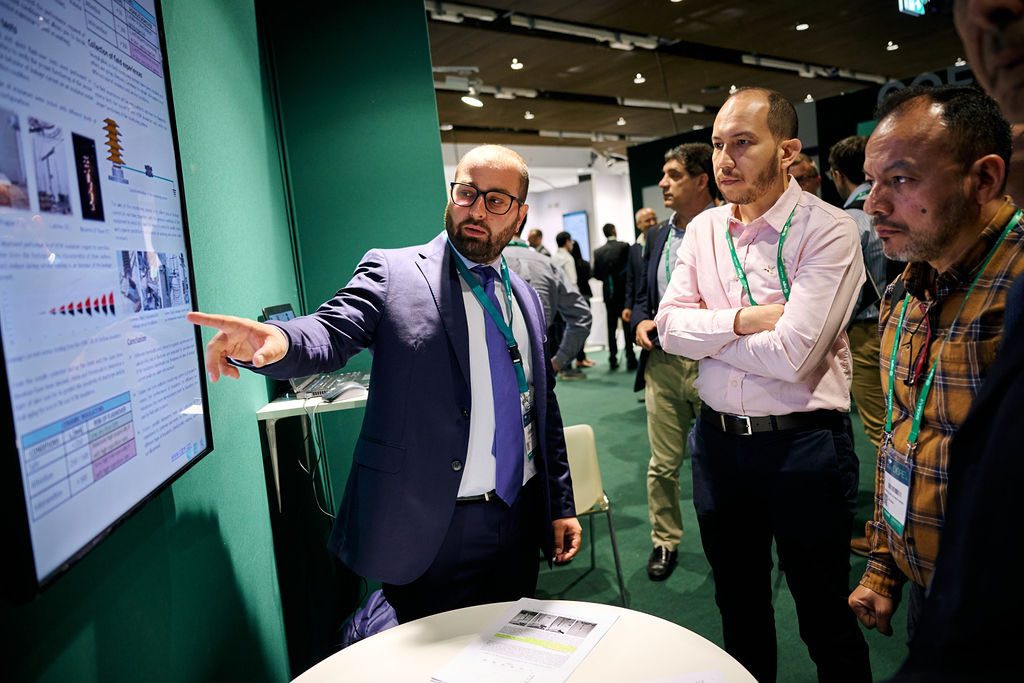
A large area is entirely dedicated to this event. Each author will have his/her own booth with a monitoring screen.
The meeting duration is usually two hours but can be adjusted according to the number of presentations.
Authors will upload their presentation for Poster Session on a dedicated website.
Authors and co-authors who cannot attend the Session may ask then someone to present the Paper - a colleague for instance - so that each Paper could be presented at the Poster Session meeting.
Important!
Prepared contributions at Group Discussion Meetings and Papers presentation at Poster Sessions can be made only by registered delegates, who will attend the meetings in person – no remote participation.
Authors or co-authors who cannot attend the Session may ask then someone to present the Paper - a colleague for instance - so that each Paper could be presented at the Poster Session meeting.
Download the Call for Papers
Preferential Subjects
PS 1: Rotating electrical machines and the energy transition
- Impact of the energy transition on the role, duty and flexible operation of rotating electrical machines
- Eco-design and sustainability
- Update of international standards for electrical machine requirements to reflect future applications
PS 2: New machine developments
- Technology developments for wind generators, variable speed pump-storage, synchronous compensators and SMR applications
- Improvements in design, manufacture, efficiency, insulation, cooling, bearings and materials
- Enhancements in the performance, reliability and control of rotating electrical machines
PS 3: Asset management and new challenges
- Digital twin: Condition monitoring, diagnosis, prognosis of rotating electrical machines including the use of artificial intelligence, deep learning techniques, Industry 5.x requirements
- Improved maintenance practices to ensure power supply reliability
- Extending operational performance and service life of installed base
PS 1: Major challenges to the Power transformer industry
- Impact of ageing fleet, new operating requirements and climate changes on the design, maintenance and reliability.
- Strategies to mitigate supply chain disruptions and skilled labor shortages.
- Sustainability (with C3) and Life Management: Transformer economics, Life Cycle Costing, Asset management practices, Eco-design. Life Cycle Assessment, circular economy.
PS 2 : Power Transformer Digitalisation Journey
- User experiences, challenges and solutions with transformer data management: data collection, processing, exchange with different stakeholders/systems, confidentiality, and security.
- Innovative digital solutions for monitoring, diagnostics, modeling, designing, manufacturing, testing, maintenance and operation of transformers.
PS 3: Failure prevention, detection and investigation
- Detailed case histories of failures including examples such as component issues, short-circuits, moisture, dielectric breakdowns, paper degradation, material compatibility problems, etc.
- Guidelines for conducting investigations: Root Cause Analysis (RCA) including testing and troubleshooting procedures.
- Predictive maintenance: Best practices for monitoring, diagnostics, and prognostics.
PS 1: Transformation of T&D assets for evolving grid conditions
- Innovative current limiting solutions for distribution & transmission networks
- Innovation in and field experience of T&D equipment to enhance system flexibility, resilience, stability and connectivity
- Application of T&D equipment in meshed DC-grids
PS 2: Sustainability and circular economy of T&D equipment
- Use of recycled material and refurbished components in T&D equipment
- Alternatives to SF6 and field experience in applications; impact of PFAS regulations on T&D equipment design
- Impact of low power instrument transformers and smart sensors
PS 3: Asset Management strategies for T&D equipment
- Integration of sensors in T&D Equipment for enhanced monitoring
- Efficient data management and information sharing for T&D condition assessment
- Utilizing digital twins, IoT, and AI for T&D equipment management
PS 1: Future cable systems and innovative cable applications.
- Cable systems challenges and solutions such as floating applications/deep water, meshed DC grids, overhead-line/substation interfaces
- New developments on materials, design and construction challenges such as super-conducting solutions, hydrogen inclusion, high temperature / electric stress, very large conductors and cost-effectiveness
- Intelligence into cables. Integration of sensor technologies, real-time use of data, predictive maintenance, use of robotics, dynamic management of load demands, digital twins, data use for BIM implementation
PS 2: Recent experience with AC and DC cables, both land and submarine
- Quality, monitoring, condition assessment, diagnostic testing, after installation testing, fault location, upgrading and uprating methodologies and relevant management
- Lessons learned from permitting, consent, interface management cables to other equipment/device/substations and safety issues
- Experiences with new test requirements and new tools for cable ratings calculation
PS 3: Environmental impact and cable lifecycle
- Development in more sustainable materials and production methods, recover, recycle, reuse of cable materials and SF6 alternatives
- Best practices in LCA and environmental certification
- Environmental impact of cable systems with regards to climate change
PS 1 : OHL modernization and emerging technologies
- Uprating or upgrading existing lines including conductors replacement and associated towers modifications and foundations reinforcement and other line components and technologies
- Accelerating the design and construction of new lines, reducing the cost and the manpower required in view of scarcity of skilled workforce and expertise
- Preassembled overhead line components, manless installation of overhead line components
PS 2 : Health assessment and refurbishment of OHL
- Remaining life of assets, increasing the life of assets, and refurbishment of OHL
- Reduced maintenance and operation costs, evaluate durability and maintenance costs
- Monitoring, predictive maintenance and digital twins
PS 3: Sustainability and climate change impacts (with C3)
- Impact and strategies in response to climate change and extreme events such as extreme winds, icing, wild fires and floods
- Environmental and social compliance challenges for OHL, life cycle assessment analysis,and carbon footprint
PS 1 : Innovative substation concepts, designs and operation experience
- Experience with digital design, training tools using 3D software, AI and machine learning
- Modular substations and prefabricated material design methods for all voltage classes
- UHV or HVDC operational experience with renewables for onshore and offshore substations
PS 2: Life cycle & asset management
- Monitoring, diagnostics and testing equipment to improve energy efficiency and functionality to reduce C02 as well as improve resiliency
- Substation up-rating, upgrading experience and operation concepts
- Asset management strategies including optimised maintenance, SF6 transitions and improve resiliency
PS 3 : Grid transformation and new reliability threats
- Physical security designs and experience
- Substation designs ,upgrades and concepts to mitigate severe weather
- Experience building substations to connect large customers such as data centers, reliably and safely
PS 1 : DC equipment and systems
- Planning, design, performance, testing and commissioning of DC equipment and systems including point to point, multiterminal and DC grids, especially offshore DC systems
- Refurbishment and upgrade of existing DC systems
- Service and operating experience of DC converter stations and systems especially VSC based DC systems and offshore DC systems
PS 2: FACTS and power electronics (PE)
- Planning, design, performance, testing and commissioning of FACTS and other PE devices including inverter-based generation
- Refurbishment and upgrade of existing FACTS and other PE devices
- Service and operating experience
PS 3: New technologies and concepts of DC and FACTS enabling energy transition
- New technologies/concepts to address network issues such as application of synchronous grid forming converters, multi-vendor interoperability, standardisation.
- New concepts, technologies and design of DC converters and PE devices for both transmission and distribution systems including interfacing generation and storage to the network, energy hubs/islands, etc.
PS 1 : Knowledge management in the field of protection, automation, control, metering and monitoring
- Knowledge and skills and their preservation
- Education, training and life-long learning of students, young professionals, academics and manufacturer and utility personnel
- Platforms, methodology, tools and support for documentation and educational delivery
PS 2 : Protection and control in networks with unconventional sources
- Best practices and regulatory and performance requirements for protection and control in networks dominated by unconventional sources, including wind and solar generation, battery storage, HVDC links and other converter-based devices
- Lessons learned and field experience with protection and control in networks dominated by unconventional sources, including fault-ride through and transient behaviour
- New developments in protection and fault response control of unconventional sources
PS 1 : Holistic planning of an integrated energy system for the energy transition
- Sustainable scenarios encompassing gases, heat, mobility, IT (data centres) as loads and as flexibility sources
- Planning methodologies and modelling targeting net zero while ensuring adequacy of resources and increased resilience
- Prioritisation of asset management plan and allocation of capital, including role of private investments in transmission networks
PS 2 : Strategic investment decisions in the context of the energy transition
- Optimal portfolio mix of transmission, generation, storage and non-wire solutions for ensuring adequacy, resilience and flexibility, and relevant governance framework
- Investment economics and risk analysis in the new energy landscape
- Sustainable asset management practices, especially for aging infrastructures
PS 3: Planning the cyber-physical system
- Impact of digitalisation on power system planning: role of AI, digital twins, big data
- Integration of physical, cyber and electrical security with asset management techniques
- Case studies of successful applications of modelling and digital tools in power system planning
PS 1 : Advanced decision support, training and skills for control room personnel
- New requirements for personnel skills, procedures and tools
- Digitalization and use of artificial intelligence for enhancing decision support
- Operational procedures, tools and processes for operating grids during extreme events
PS 2 : Maintaining operational reliability through flexibility
- Methods to identify and quantify system services in response to the energy transition
- Operational experience with flexibility services, including demand side response, topology changes, sector coupling and results from pilots
PS 3 : Power system dynamics and control in operations
- Operational experience with managing power system stability, including oscillations
- Monitoring and control of power system dynamics in the control room, including wide area systems
- Impact of adverse interactions between power electronics interfaced devices on system operations
PS 1: Biodiversity conservation & enhancement. Towards positive contribution.
- Mitigating the impact from power system infrastructure: new renewable generation facilities, transmission and distribution. Preventive and corrective measures: nature inclusive design, commissioning, asset management and end of life.
- Offsetting measures & ecosystems restauration. Net Zero impact and positive impact. How to measure?
- New standards regarding biodiversity. i.e. IPBES; TCNFD.
PS 2: Building a more sustainable power system for the future
- Identification, quantification and assessment of impacts. Tools and methodologies. LCA approach, considering climate change and beyond.
- Eco-design to reduce impacts
- Innovative solutions to enhance circularity.
PS 3: Disclosing sustainability
- Reporting standards & regulation. Indicators.
- −Stakeholder reporting requirements. Impact of disclosure on social perception and acceptance.
- Value chain information, strategies and methodologies to obtain complete and reliable information.
PS 1: Power system stability aspects of decarbonisation of power systems and the road to net-zero
- Emerging tools and methods for plant and system-wide stability analysis, model validation, advanced data analytics, screening and performance monitoring.
- Power system stability impact of new technologies including storage, large scale inverter-based generators, inverter-based loads, network elements and control methods (e.g. grid forming). Development of appropriate specifications.
- Dynamic phenomena impacting power systems stability - e.g. wide-area, local interactions and forced oscillations.
- Demystifying system strength: definition, metrics, impact on power systems, experiences, challenges and solutions.
PS 2: Power quality (PQ) and electromagnetic compatibility/interference (EMC/EMI) aspects of decarbonisation of power systems and the road to net-zero
- Modeling and simulation for assessment of PQ and EMC phenomena and mitigation strategies in meshed transmission systems.
- Experiences with PQ issues in IBR dominated systems and use of advanced data analytics to investigate trends. Approaches for allocation of PQ limits and compliance processes.
- Experiences with EMI for large inverter-based generators and loads and interference between the power system (AC or DC) and pipelines and telecom systems.
PS 3: Insulation co-ordination and lightning research: paving the way to net-zero in decarbonised power systems
- Future of insulation co-ordination for AC, DC and hybrid systems.
- Improvement of lightning detection systems with a focus to enhance power system reliability.
- Lightning protection designs and accepted risk of damage to IBRs, including the impact of thunderstorms and extreme weather events.
PS 1: Market designs and non-market approaches to support the energy transition
- Ensuring resource adequacy and supporting investment decisions
- Cost allocation for the energy transition: who owns and who pays
- Tradeoffs between markets and regulatory approaches
PS 2: Developing reliable price signals and regulations across the value chain
- Tools and approaches for markets to withstand adverse events and shocks
- Consistent end-to-end price signals to integrate emerging technologies, distributed energy resources and energy communities
PS 3: Applying practical experiences to emerging issues
- Integrating various electricity markets with emission reduction approaches and long-term contracts
- Market designs and products to deal with increasing short-term uncertainty
- Data analytics in electricity markets, market surveillance and transparency
PS 1 : Enabling flexibility in distribution networks
- Impact of and grid services provision by energy storage systems and energy conversion units e.g. hydrogen, in distribution systems
- The role of energy communities, aggregators and virtual power plants to enhance the flexibility of distribution networks
- Risk appetite in times of network congestion and the balance between flexibility procurement and stretching operational limits
PS 2 : Planning and operations for 2030 and beyond in active distribution systems
- The impact of transformational changes to planning objectives and criteria, with accelerated electrification, new electric loads and customer behaviours
- Electric vehicle integration and further evolving technology impacts on the distribution system
- The role of the DSO to manage and plan the system operations and to improve network resilience of distribution networks, considering customer affordability
PS 3 : Rural and industrial electrification standards, practices and technology options
- Microgrid and multi-microgrid installations, including industry networks
- Off-grid and island DER applications including appropriate resilience measures
- Applications highlighting the connection of the last mile of rural electrification projects
PS 1: Testing, monitoring and diagnostics
- Testing and condition monitoring for reliability in conventional high voltage systems and power electronics applications.
- Understanding of space charge and PD behaviour under AC, DC, rectifier, and impulse stress.
- Advances in knowledge rules and tools for improved diagnostics including ML, AI, explainable AI (XAI) etc. considering multiple data sources or contextual information.
PS 2: Materials for electrotechnical purposes and modelling
- Ageing of materials under electrical, mechanical or thermal stresses and associated ageing markers.
- Modelling materials and field simulations under AC, DC and composite voltages.
- Application of novel materials and processes; eco-friendly and recycled materials, materials to enable energy storage or cryogenic systems, additive manufacturing etc.
PS 3: Measurements and modelling of interfaces
- Understanding interfacial behaviour through experiments at any scale between the nano- and macro-scale.
- Modelling electric field, magnetic field, or charge dynamics at interfaces.
- Assessing material compatibility of used and unaged materials.
PS 1: Extracting value from information and data through decision support tools and techniques in managing the increasing complexity of power grids
- Predictive analytics techniques to forecast generation from renewable sources/distributed energy resources
- Case studies and guidelines for AI application in power system operation and planning
- Development of AI and machine learning models for real-time and predictive grid optimisation
PS 2: Comprehensive approaches to managing cybersecurity in energy applications
- Cybersecurity compliance, obligations, regulations and legislations in the energy sector, including cybersecurity organisational processes, technical measures, standards, and certifications.
- Integrated solutions for physical and cyber threat detection platforms to support asset and incident management, including artificial intelligence techniques
- New strategies and approaches for protecting energy infrastructures and sensitive data against cyber threats
PS 3: Next-generation telecommunications technologies to support grid decarbonisation and digitalisation
- Optimised migration approach from legacy to packet networks to support mission-critical power systems services
- Next-generation technologies in enhancing coverage and resilience of wireless communication networks for power systems.
- Telecommunications technologies and techniques for a highly resilient and mission-critical power system.
Key dates
| Authors | National Committees |
|---|---|
| July 7, 2025: deadline to send synopses to National Committees | August 25, 2025: deadline to send synopses to Central Office |
| October 20, 2025: synopses formal notification of acceptance by Central Office | |
| January 12, 2026: deadline to send full Papers to National Committees | February 2, 2026: deadline to send full Papers to Central Office |
| April 10, 2026: deadline to send revised version of full Papers | April 20, 2026: deadline to send revised version of full Papers |
| May 11, 2026: Full Papers formal notification of acceptance by Central Office | |
| June 29, 2026: deadline for Poster presentations | Authors upload directly on ConfTool® portal. National Committees are not involved |
| August 7, 2026: deadline for contributions at Group Discussion Meetings | Authors upload directly on CIGRE registration portal. Natinoal Committees are not involved |
